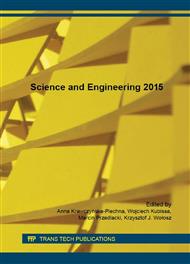[1]
D. J. Hayes, J. Ross, M. H. B. Hayes, S. Fitzpatrick, The Biofine Process: Production of levulinic acid, furfural and formic acid from lignocellulosic feedstocks, in: B. Kamm, P. R. Gruber, M. Kamm (Eds. ), Biorefineries: Industrial Processes and Products, Wiley, Weinheim, 2006, pp.139-159.
DOI: 10.1002/9783527619849.ch7
Google Scholar
[2]
S.W. Fitzpatrick, Production of levulinic acid from carbohydrate-containing materials, US Patent 5608105, (1997).
Google Scholar
[3]
D.B. Bevilaqua, M. K. D. Rambo, T. M. Rizzetti, A. L. Cardoso, A. F. Martins, Cleaner production: levulinic acid from rice husks, J. Clean. Prod. 47 (2013) 96-101.
DOI: 10.1016/j.jclepro.2013.01.035
Google Scholar
[4]
A. M. Raspolli Galletti, C. Antonetti, V. De Luise, D. Licursi, M. N. o Di Nasso, Levulinic acid production from waste biomass, BioResources, 7 (2012) 1824-1835.
DOI: 10.15376/biores.7.2.1824-1835
Google Scholar
[5]
L. Yan, N. Yang, H. Pang, B. Liao, Production of levulinic acid from bagasse and paddy straw by liquefaction in the presence of hydrochloride acid, CLEAN – Soil, Air, Water, 36 (2008) 158-163.
DOI: 10.1002/clen.200700100
Google Scholar
[6]
J. Ahlkvist, Doctoral Thesis: Formic and levulinic acid from cellulose via heterogeneous catalysis, Umea University, Sweden, (2014).
Google Scholar
[7]
Y. Takeuchi, F. Jin, K. Tohji, H. Enomoto, Acid catalytic hydrothermal conversion of carbohydrate biomass into useful substances, J. Mater. Sci. 43 (2008) 2472-2475.
DOI: 10.1007/s10853-007-2021-z
Google Scholar
[8]
Q. Fang, M. A. Hanna, Experimental studies for levulinic acid production from whole kernel grain sorghum, Bioresource Technol. 81 (2002) 187-192.
DOI: 10.1016/s0960-8524(01)00144-4
Google Scholar
[9]
V. E. Tarabanko, M. Yu. Chernyak, S. V. Aralova, B. N. Kuznetsov, Kinetics of levulinic acid formation from carbohydrates at moderate temperatures, React. Kinet. Catal. L. 75 (2012) 117-126.
DOI: 10.1023/a:1014857703817
Google Scholar
[10]
A. Mukherjee, M. -J. Dumont, V. Raghavan, Review: Sustainable production of hydroxymethylfurfural and levulinic acid: challenges and opportunities, Biomass Bioenerg. 72 (2015) 143-183.
DOI: 10.1016/j.biombioe.2014.11.007
Google Scholar
[11]
F. S. Asghari, H. Yoshida, Acid-catalyzed production of 5-hydroxymethyl furfural from D-fructose in subcritical water, Ind. Eng. Chem. Res. 45 (2006) 2163-2173.
DOI: 10.1021/ie051088y
Google Scholar
[12]
R. Weingarten, Y. Tae Kim, G. A. Tompsett, A. Fernández, K. Sung Han, E. W. Hagaman, Wm. C. Conner Jr, J. A. Dumesic, G. W. Huber, Conversion of glucose into levulinic acid with solid metal(IV) phosphate catalysts, J. Catal. 304 (2014) 123-134.
DOI: 10.1016/j.jcat.2013.03.023
Google Scholar
[13]
N. Ya'aini, N. A. Saidina Amin, S. Endud, Characterisation and performance of hybrid catalysts for levulinic acid production from glucose, Micropor. Mesopor. Mat. 171 (2013) 14-23.
DOI: 10.1016/j.micromeso.2013.01.002
Google Scholar
[14]
H. Ren, Y. Zhou, L. Liu, Selective conversion of cellulose to levulinic acid via microwave-assisted synthesis in ionic liquids, Biores. Technol. 129 (2013) 616-619.
DOI: 10.1016/j.biortech.2012.12.132
Google Scholar
[15]
B.C. Windom, T. M. Lovestead, M. Mascal, E. B. Nikitin, T. J. Bruno, Advanced distillation curve analysis on ethyl levulinate as a Diesel fuel oxygenate a hybrid biodiesel fuel, Energ. Fuel, 25 (2011), 1879-1886.
DOI: 10.1021/ef200239x
Google Scholar
[16]
S. Devi, H. Bhaskar, K. Kundu, V. R. Dahake, Production of ethyl levulinate (an additive to biodiesel) using paper waste, Intern. J. Curr. Eng. and Techn., 3 (2013), 672-676.
Google Scholar
[17]
A. Demolis, N. Essayem, F. Rataboul, Synthesis and applications of alkyl levulinates, ACS Sustainable Chemistry & Engineering, 2 (2014), 1338-1344.
DOI: 10.1021/sc500082n
Google Scholar
[18]
E. Christensen, R. L. McCormick, A. Williams, J. Yanowitz, S. Paul, S. Burton, Chemical and performance properties of levulinate esters as fuel blend components, American Chemical Society, Division of Fuel Chemistry, 56 (2011) 501-502.
DOI: 10.1021/ef201229j
Google Scholar
[19]
J. M. Climent, A. Corma, S. Iborra, Conversion of biomass platform molecules into fuel additives and liquid hydrocarbon fuels, Green Chem. 16 (2014), 518-519.
DOI: 10.1039/c3gc41492b
Google Scholar
[20]
A. C. Cole, J. L. Jensen, I. Ntai, K. L. T. Tran, K. J. Weaver, D. C. Forbes, J. H. Davis Jr, Novel Broensted acidic ionic liquids and their use as dual solvent-catalysts, J. Amer. Chem. Soc. 124 (2002) 5962-5963.
DOI: 10.1021/ja026290w
Google Scholar
[21]
B. I. Oliveira, V. Teixeira da Silva, Sulfonated carbon nanotubes as catalysts for the conversion of levulinic acid into ethyl levulinate, Catal. Today 234 (2014) 257-263.
DOI: 10.1016/j.cattod.2013.11.028
Google Scholar
[22]
G. D. Yadav, A. R. Yadav, Synthesis of ethyl levulinate as fuel additives using heterogeneous solid superacidic catalysts: Efficacy and kinetic modeling, Chem. Eng. J. 243 (2014) 556-563.
DOI: 10.1016/j.cej.2014.01.013
Google Scholar
[23]
Y. Kuwahara, W. Kaburagi, K. Nemoto, T. Fujitani, Esterefication of levulinic acid with ethanol over sulfated Si-doped ZrO2 solid acid catalyst: Study of the structure – activity relationships, Appl. Catal. A Gen. 476 (2014) 186-196.
DOI: 10.1016/j.apcata.2014.02.032
Google Scholar
[24]
C. R. Patil, P. S. Niphadkar, V. V. Bokade, P. N. Joshi, Esterification of levulinic acid to ethyl levulinate over bimodal micro-mesoporous H/BEA zeolite derivatives, Catal. Comm., 43 (2014) 188-191.
DOI: 10.1016/j.catcom.2013.10.006
Google Scholar
[25]
G. Pasquale, P. Vázquez, G. Romanelli, G. Baronetti, Catalytic upgrading of levulinic acid to ethyl levulinate using reusable silica-included Wells-Dawson heteropolyacid as catalyst, Catal. Comm. 18 (2012) 115-120.
DOI: 10.1016/j.catcom.2011.12.004
Google Scholar
[26]
D. Song, S. An, B. Lu, Y. Guo, J. Leng, Arylsulfonic acid functionalized hollow mesoporous carbon spheres for efficient conversion of levulinic acid or furfuryl alcohol to ethyl levulinate, Appl. Catal. B Env. 179 (2015) 445-457.
DOI: 10.1016/j.apcatb.2015.05.047
Google Scholar


